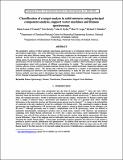| dc.contributor.author | Madden, Michael G. | en |
| dc.contributor.author | Leger, Marc N. | en |
| dc.contributor.author | Ryder, Alan G. | en |
| dc.contributor.author | Howley, Tom | en |
| dc.contributor.author | O Connell, Marie-Louise | en |
| dc.date.accessioned | 2009-05-15T10:24:13Z | en |
| dc.date.available | 2009-05-15T10:24:13Z | en |
| dc.date.issued | 2005 | en |
| dc.identifier.citation | Classification of a Target Analyte in Solid Mixtures using Principal Component Analysis, Support Vector Machines and Raman Spectroscopy , Marie-Louise O'Connell, Tom Howley, Alan G. Ryder, Marc N. Leger & Michael G. Madden, Proceedings of SPIE, the International Society for Optical Engineering, Vol. 5826, pp 340-350, 2005. | en |
| dc.identifier.uri | http://hdl.handle.net/10379/192 | en |
| dc.description.abstract | The quantitative analysis of illicit materials using Raman spectroscopy is of widespread interest for law enforcement and healthcare applications. One of the difficulties faced when analysing illicit mixtures is the fact that the narcotic can be mixed with many different cutting agents. This obviously complicates the development of quantitative analytical methods. In this work we demonstrate some preliminary efforts to try and account for the wide variety of potential cutting agents, by discrimination between the target substance and a wide range of excipients. Near-infrared Raman spectroscopy (785 nm excitation) was employed to analyse 217 samples, a number of them consisting of a target analyte (acetaminophen) mixed with excipients of different concentrations by weight. The excipients used were sugars (maltose, glucose, lactose, sorbitol), inorganic materials (talcum powder, sodium bicarbonate, magnesium sulphate), and food products (caffeine, flou). The spectral data collected was subjected to a number of pre-treatment statistical methods including first derivative and normalisation transformations, to make the data more suitable for analysis. Various methods were then used to discriminate the target analytes, these included Principal Component Analysis (PCA), Principal Component Regression (PCR) and Support Vector Machines. | en |
| dc.format | application/pdf | en |
| dc.language.iso | en | en |
| dc.rights | Attribution-NonCommercial-NoDerivs 3.0 Ireland | |
| dc.rights.uri | https://creativecommons.org/licenses/by-nc-nd/3.0/ie/ | |
| dc.subject | Raman spectroscopy | en |
| dc.subject | Forensic sciences | en |
| dc.subject | Classification | en |
| dc.subject | Chemometrics | en |
| dc.subject | Support vector machines | en |
| dc.subject.lcsh | Raman spectroscopy | en |
| dc.subject.lcsh | Forensic sciences | en |
| dc.subject.lcsh | Chemometrics | en |
| dc.subject.lcsh | Support vector machines | en |
| dc.title | Classification of a Target Analyte in Solid Mixtures using Principal Component Analysis, Support Vector Machines and Raman Spectroscopy | en |
| dc.type | Conference Paper | en |
| nui.item.downloads | 535 | |


